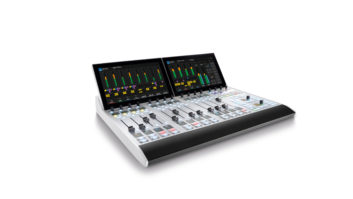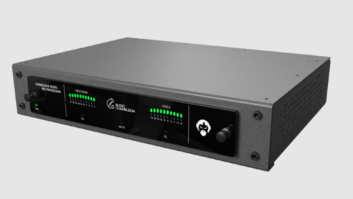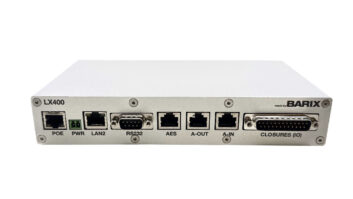ORLANDO, Fla. — Broadcast audio delivery over the public Internet can be a tough sell. A growing number of radio stations are opening up to this concept thanks to ongoing technology improvements.
Barix is one such company that does IP audio delivery particularly well. I operate two satellite teleports that support a number of broadcasters, including a leading U.S. Hispanic broadcaster Stardome Radio Networks. We use Barix exclusively for IP audio delivery across Stardome and the other broadcast networks we support.
INTERNET AUDIO
Barix has to date replaced a series of satellite, ISDN and POTS equipment for our broadcast audio delivery. ISDN availability is shrinking. Satellite is expensive and the technology is clunky — not to mention old. Satellite introduces a new technology platform every 8–10 years, and translates to an upgrade investment of between $35–50K per headend.

We have added Barix to our master control center and affiliates as way of reducing costs and simplifying infrastructure. We can easily push audio to a new Barix device at a remote location and be on the air quickly. This includes live remote broadcasts, where we traditionally had used POTS. We just plug the Barix box into a standard DSL connection and we’re ready to broadcast.
Our Barix device of choice is the Exstreamer 500, which offers the option to encode or decode audio. At less than $600 each, the cost is far less expensive than satellite and we have the option to configure the devices anyway we want. And the ongoing investment in the public Internet means that the reliability of connection is comparable to that of satellite and ISDN.
Speaking of evolution, the Exstreamer 500 is a major advancement from the Exstreamer 100 for the broadcast environment. The biggest design benefits include the addition of balanced audio connections and contact closures.
The balanced inputs and outputs remove the need for a Henry Engineering Matchbox or similar component to connect the device in a studio or transmitter environment. It saves a lot of time and eliminates any associated audio loss. The devices become truly plug-and-play with this improvement.
The contact closures provide the most important enhancement for the Stardome operation. The closures essentially allow us to operate as a network headend, delivering data triggers to automation systems for local breaks and returns. This enables each affiliate to air local commercials and understand when to come back to network programming. The Barix devices also send ID closures so affiliates can play legal station identification messages and remain in compliance.
Ultimately, Barix removes a lot of the guesswork that stations experience when relying on tone decoders, which are difficult to calibrate and use uninterrupted. The Exstreamer 500 acts as a remote control to run a radio station in automated fashion, taking away much of the complexity.
Stardome Radio Networks uses the Exstreamer 500 to both encode and decode audio. One example is for Mex-Mix, a regional Mexican music format that includes two popular daily shows. The live host feeds are brought into our master control center in Orlando using bidirectional Exstreamer 500s.
SAVINGS
The 500s encode and decode audio in both directions using Barix STL firmware, streaming high-quality WAV audio between two static IP addresses. The clarity of the audio, delivered in the WAV format, is incredible. It is hard to believe on first listen that this kind of quality is being delivered over the public Internet.
Outgoing affiliate feeds are mono-directional, point-to-multipoint. The Orlando Exstreamer 500s are configured as encoding devices, with the affiliate devices configured to decoder settings. The devices are configured in Orlando and shipped to the affiliates, where engineers plug the closures into their automation systems of choice. Barix STL firmware again supports audio delivery. All feeds are streamed as high-quality MP3, since not every location has the bandwidth to support WAV delivery.
Another impressive Barix benefit is low latency. It might be slightly longer than satellite, but not so much that it is noticeable. We have tested latency between central Florida and the furthest corner of the Pacific Northwest, experiencing about three or fourth-tenths of a second in program delay. Barix has addressed the elastic latency of Internet delivery, compensating with a stable and predictable streaming solution.
Barix significantly reduces our monthly operational costs. Terrestrial bandwidth is far less expensive than satellite, where a single stream costs about $1,500 a month in space-segment expenses alone. Add another $1,500 a month for uplink costs, and toss in equipment depreciation, electricity and other expenses tied to owning a satellite teleport.
In comparison, our total bandwidth costs with Barix hover near $1,000 a month for multiple streams to multiple stations. It is a remarkable reduction in expenses. The equipment is also easier to maintain as there is no need to retune the satellite dish following each storm.
Everything will be delivered over IP in the future. The fact that we can deliver this much audio at the quality and cost we are at this stage is exciting. Satellite will never go away, and in fact Barix technology is often complementary to our satellite operation. But we believe that IP audio delivery and companies like Barix are helping radio get back to what it’s about: Local service to local communities, and at a very reasonable price.
For information, contact Andy Stadheim at Barix in Minnesota at (866) 815-0866 or visit www.barix.com.












